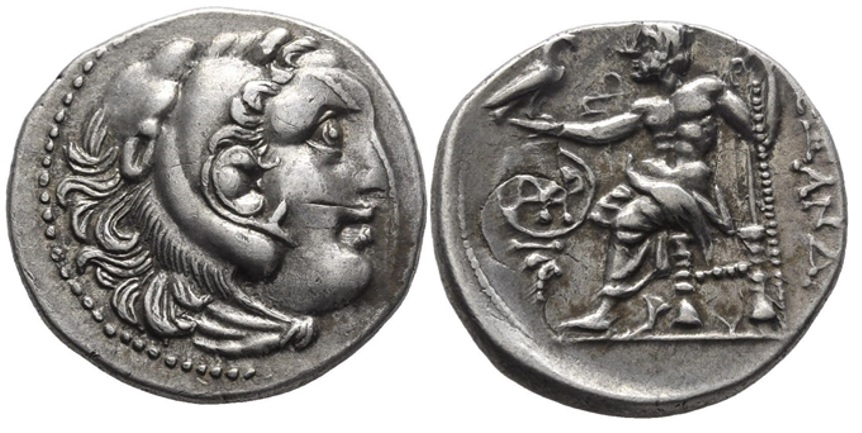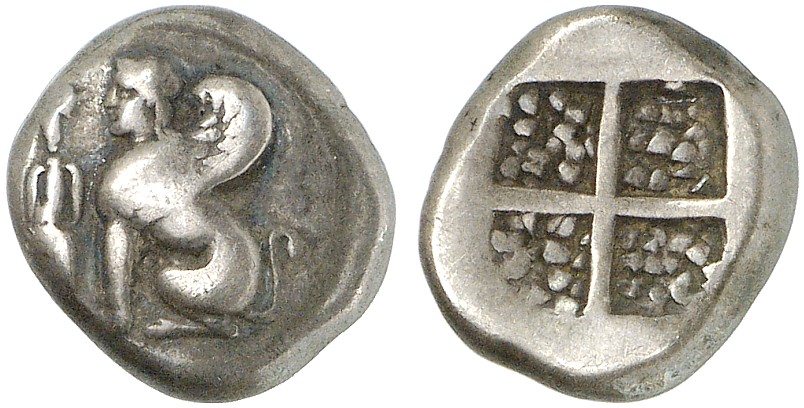Latest revision as of 17:31, 17 November 2023
290 BCE - 275 BCE | AΛΕΞANΔΡΟΥ
Overstriking coin
Chios SO 781.jpg
Overstruck variety
Chios 391.jpg
|
|
Sale(s)Sale(s) ᵖ:
|
Lanz on Ebay, 25 Aug. 2018
|
|
|
|
Description
| ObverseInscription or printing placed on the obverse.:
|
Head of Herakles right, wearing lion skin headdress. Border of dots.
|
ReverseInscription or printing placed on the reverse.:
|
AΛΕΞANΔΡΟΥ (Greek) Zeus enthroned left, holding eagle and scepter. In field, monogram (MYPO) and grapes.
|
Mint and issuing power
| MintIdentifies the place of manufacture or issue of a numismatic object.:
|
Chios
|
Ancient regionAncient region.
|
Ionia
|
Modern countryModern country: Greece
|
AuthorityIdentifies the issuing power. The authority can be "pretended" when the name or the portrait of X is on the coin but he/she was not the issuing power. It can also be "uncertain" when there is no mention of X on the coin but he/she was the issuing power according to the historical sources:
|
Alexander III the Great (Argead king, 336-323 BC)
|
Chronology
| FromIdentifies the initial date in a range assigned in a numismatic context. 290 BCE toIdentifies the final date in a range assigned in a numismatic context.. 275 BCE
|
Hellenistic 323-30 BC  periodTime period of the numismatic object. periodTime period of the numismatic object.
|
Physical description
MetalThe physical material (usually metal) from which an object is made.: Silver 
|
WeightWeight of the numismatic object (in grams). in grams: 4.084.08 g <br />4,080 mg <br />
|
DenominationTerm indicating the value of a numismatic object. Examples: tetradrachm, chalkous, denarius.: drachma 
|
|
| DiameterDescribes diameter of an object (in mm).: 1919 mm <br />1.9 cm <br />
|
StandardStandard.: Attic
|
References
Description
| ObverseInscription or printing placed on the obverse.:
|
Sphinx seated left, amphora surmounted by bunch of grapes before
|
ReverseInscription or printing placed on the reverse.:
|
Quadripartite incuse square
|
Mint and issuing power
| MintIdentifies the place of manufacture or issue of a numismatic object. ᵖ:
|
Chios
|
Ancient regionAncient region. ᵖ
|
Ionia
|
Modern countryModern country: Greece
|
AuthorityIdentifies the authority in whose name (explicitly or implicitly) a numismatic object was issued. ᵖ:
|
|
Chronology
| FromIdentifies the initial date in a range assigned in a numismatic context. 380 BCE toIdentifies the final date in a range assigned in a numismatic context.. 330 BCE
|
Classical 480-323 BC  periodTime period of the numismatic object. periodTime period of the numismatic object.
|
Physical description
| DenominationTerm indicating the value of a numismatic object. Examples: tetradrachm, chalkous, denarius. ᵖ:
|
drachma 
|
StandardStandard. ᵖ:
|
Attic
|
References

